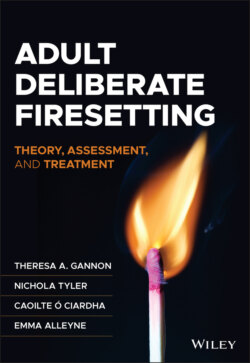Читать книгу Adult Deliberate Firesetting - Theresa A. Gannon - Страница 15
Sexual Offending Literature as a Guiding Framework
ОглавлениеGiven the paucity of the adult firesetting literature pre-2010, researchers turned to more established literatures (i.e., sexual offending) to inform the research agenda moving forward. However, although early theorising suggested a relationship between firesetting and sexual dysfunction, little available evidence substantiates this link as a major explanatory factor for adult firesetting (Ó Ciardha, 2015). Research on sexual offending has nonetheless been influential in developing knowledge relating to firesetting. This is likely the result of the longstanding recognition of sexual offending—particularly child sexual abuse—as a public health problem in need of sustained research to develop knowledge for prevention and treatment. As a result, the burgeoning field of research on deliberate adult firesetting has been able to draw on practices and concepts from the more established field of research on sexual offending.
A key influence of the field of sexual offending on firesetting research has been work by Tony Ward and various collaborators. The Multi-Trajectory Theory of Adult Firesetting (M-TTAF; Gannon et al., 2012) is an example of theorising in firesetting that draws inspiration from work, including that of Ward and Beech (2006), Ward and Hudson (1998), and Ward et al. (2006), on how to effectively develop, appraise, and knit together theories in sexual offending. Models of the offence process (micro theories) of firesetting behaviour (e.g., Barnoux et al., 2015; Tyler et al., 2014) also used methods applied by Ward et al. (1995) to the investigation of the offence process of people who sexually offend against children. Furthermore, Ward hypothesised that implicit theories (Ward, 2000; Ward & Keenan, 1999) and offence scripts (Ward & Hudson, 2000) form part of an explanatory framework for the offence-supportive belief systems of people who commit sexual offences. These concepts have been highly influential in theory development (e.g., Butler & Gannon, 2015; Ó Ciardha & Gannon, 2012; see Chapter 3) and empirical research (e.g., Barrowcliffe et al., 2019; Butler & Gannon, 2021) on firesetting behaviour.
Changes and developments in the treatment of sexual offending over the past number of decades have also influenced current practice in the treatment of firesetting. For example, those interested in best practice with people who have sexually offended have been confronted with questions around dealing with clients who deny or minimise their offending. Similarly practice regarding treatment of sexual offending has had to navigate whether treatment ethos is most effective using a risk-based or a strengths-based approach. Building from the evidence base around what works for sexual offending has allowed contemporary intervention programmes for people who have been apprehended for firesetting (see Chapters 6 and 7) to be developed, conscious of principles of risk, need, and responsivity (Andrews & Bonta, 2010) and strength-based approaches to treatment (Good Lives Model; Ward & Stewart, 2003). These intervention programmes have been able to avoid the pitfalls faced by early sexual offending practice whereby denial and minimisation posed barriers to treatment involvement (Maruna & Mann, 2006).
